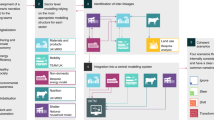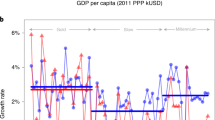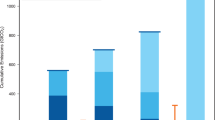Abstract
Many impacts projected for a global warming level of 2 °C relative to pre-industrial levels may exceed the coping capacities of particularly vulnerable countries. Therefore, many countries advocate limiting warming to below 1.5 °C. Here we analyse integrated energy–economy–environment scenarios that keep warming to below 1.5 °C by 2100. We find that in such scenarios, energy-system transformations are in many aspects similar to 2 °C-consistent scenarios, but show a faster scale-up of mitigation action in most sectors, leading to observable differences in emission reductions in 2030 and 2050. The move from a 2 °C- to a 1.5 °C-consistent world will be achieved mainly through additional reductions of CO2. This implies an earlier transition to net zero carbon emissions worldwide, to be achieved between 2045 and 2060. Energy efficiency and stringent early reductions are key to retain a possibility for limiting warming to below 1.5 °C by 2100. The window for achieving this goal is small and rapidly closing.
This is a preview of subscription content, access via your institution
Access options
Subscribe to this journal
Receive 12 print issues and online access
$209.00 per year
only $17.42 per issue
Buy this article
- Purchase on Springer Link
- Instant access to full article PDF
Prices may be subject to local taxes which are calculated during checkout





Similar content being viewed by others
Change history
17 March 2016
In the version of this Perspective originally published, the units in Fig. 3a and the corresponding main text should have read kgCO2 GJ−1, not tCO2 GJ−1. This error has been corrected in the online versions of this Perspective.
References
United Nations Framework Convention on Climate Change (UNFCCC, 1992).
Mahlstein, I., Knutti, R., Solomon, S. & Portmann, R. W. Early onset of significant local warming in low latitude countries. Environ. Res. Lett. 6, 034009 (2011).
Schellnhuber, H. J., Cramer, W., Nakicenovic, N., Wigley, T. M. L. & Yohe, G. (eds) Avoiding Dangerous Climate Change (Cambridge Univ. Press, 2006).
The Cancun Agreements: Outcome of the Work of the Ad Hoc Working Group on Long-Term Cooperative Action under the Convention FCCC/CP/2010/7/Add.1 Decision 1/CP.16 (UNFCCC, 2010).
Submissions from Parties FCCC/KP/AWG/2009/MISC.1/Add.1 (UNFCCC, 2009).
Earth Negotiations Bulletin (IISD Reporting Services, 2008).
Climate Change 2014: Impacts, Adaptation, and Vulnerability (eds Field, C. B. et al.) 1–32 (IPCC, Cambridge Univ. Press, 2014).
Climate Change 2013: The Physical Science Basis (eds Stocker, T. F. et al.) (IPCC, Cambridge Univ. Press, 2013).
Le Quéré, C. et al. The global carbon budget 1959–2011. Earth Syst. Sci. Data 5, 165–185 (2013).
Friedlingstein, P. et al. Persistent growth of CO2 emissions and implications for reaching climate targets. Nature Geosci. 7, 709–715 (2014).
Luderer, G. et al. Economic mitigation challenges: How further delay closes the door for achieving climate targets. Environ. Res. Lett. 8, 034033 (2013).
Rogelj, J., McCollum, D. L., Reisinger, A., Meinshausen, M. & Riahi, K. Probabilistic cost estimates for climate change mitigation. Nature 493, 79–83 (2013).
Rogelj, J., McCollum, D. L., O'Neill, B. C. & Riahi, K. 2020 emissions levels required to limit warming to below 2 °C. Nature Clim. Change 3, 405–412 (2013).
Azar, C., Johansson, D. J. A. & Mattsson, N. Meeting global temperature targets—the role of bioenergy with carbon capture and storage. Environ. Res. Lett. 8, 034004 (2013).
Ranger, N. et al. Is it possible to limit global warming to no more than 1.5 °C? Climatic Change 111, 973–981 (2012).
Kriegler, E. et al. Diagnostic indicators for integrated assessment models of climate policy. Technol. Forecast. Soc. 90, 45–61 (2015).
Meinshausen, M., Raper, S. C. B. & Wigley, T. M. L. Emulating coupled atmosphere-ocean and carbon cycle models with a simpler model, MAGICC6 – Part 1: Model description and calibration. Atmos. Chem. Phys. 11, 1417–1456 (2011).
Rogelj, J., Meinshausen, M. & Knutti, R. Global warming under old and new scenarios using IPCC climate sensitivity range estimates. Nature Clim. Change 2, 248–253 (2012).
Meinshausen, M., et al. Greenhouse-gas emission targets for limiting global warming to 2 °C. Nature 458, 1158–1162 (2009).
Schaeffer, M. et al. Mid- and long-term climate projections for fragmented and delayed-action scenarios. Technol. Forecast. Soc. 90, 257–268 (2015).
Collins, M. et al. in Climate Change 2013: The Physical Science Basis (eds Stocker, T. F. et al.) 1029–1136 (IPCC, Cambridge Univ. Press, 2013).
Clarke, L. et al. in Climate Change 2014: Mitigation of Climate Change (eds Edenhofer, O. et al.) 413–510 (IPCC, Cambridge Univ. Press, 2014).
Climate Change 2013: The Physical Science Basis (eds Stocker, T. F. et al.) 1–29 (IPCC, Cambridge Univ. Press, 2013).
The Emissions Gap Report 2013 (UNEP, 2013).
Rogelj, J. et al. Emission pathways consistent with a 2 °C global temperature limit. Nature Clim. Change 1, 413–418 (2011).
Mastrandrea, M. D. et al. Guidance Notes for Lead Authors of the IPCC Fifth Assessment Report on Consistent Treatment of Uncertainties (IPCC, 2010).
Jones, C. et al. Twenty-first-century compatible CO2 emissions and airborne fraction simulated by CMIP5 Earth system models under four Representative Concentration Pathways. J. Climate 26, 4398–4413 (2013).
Taylor, K. E., Stouffer, R. J. & Meehl, G. A. An overview of CMIP5 and the experiment design. Bull. Am. Meteorol. Soc. 93, 485–498 (2011).
van Vuuren, D. et al. RCP2.6: Exploring the possibility to keep global mean temperature increase below 2 °C. Climatic Change 109, 95–116 (2011).
Allen, M. R. et al. Warming caused by cumulative carbon emissions towards the trillionth tonne. Nature 458, 1163–1166 (2009).
Matthews, H. D., Gillett, N. P., Stott, P. A. & Zickfeld, K. The proportionality of global warming to cumulative carbon emissions. Nature 459, 829–832 (2009).
Zickfeld, K., Eby, M., Matthews, H. D. & Weaver, A. J. Setting cumulative emissions targets to reduce the risk of dangerous climate change. Proc. Natl Acad. Sci. USA 106, 16129–16134 (2009).
Solomon, S. et al. Persistence of climate changes due to a range of greenhouse gases. Proc. Natl Acad. Sci. USA 107, 18354–18359 (2010).
Solomon, S., Plattner. G-K., Knutti, R. & Friedlingstein, P. Irreversible climate change due to carbon dioxide emissions. Proc. Natl Acad. Sci. USA 106, 1704–1709 (2009).
Myhre, G. et al. in Climate Change 2013: The Physical Science Basis (eds Stocker, T. F. et al.) 659–740 (IPCC, Cambridge Univ. Press, 2013).
Climate Change 2013: The Physical Science Basis (eds Stocker, T. F. et al.) 33–115 (IPCC, Cambridge Univ. Press, 2013).
Climate Change 2014: Mitigation of Climate Change (eds Edenhofer, O. et al.) (IPCC, Cambridge Univ. Press, 2014).
Weyant, J. P., de la Chesnaye, F. C. & Blanford, G. J. Overview of EMF-21: Multigas mitigation and climate policy. Energ. J. 27, 1–32 (2006).
Blanford, G., Kriegler, E. & Tavoni, M. Harmonization vs. fragmentation: Overview of climate policy scenarios in EMF27. Climatic Change 123, 383–396 (2014).
Johnson, N. et al. Stranded on a low-carbon planet: Implications of climate policy for the phase-out of coal-based power plants. Technol. Forecast. Soc. 90(A), 89–102 (2014).
Davis, S. J., Caldeira, K. & Matthews, H. D. Future CO2 emissions and climate change from existing energy infrastructure. Science 329, 1330–1333 (2010).
Krey, V., Luderer, G., Clarke, L. & Kriegler, E. Getting from here to there – energy technology transformation pathways in the EMF27 scenarios. Climatic Change 123, 369–382 (2014).
Riahi, K. et al. in Global Energy Assessment - Toward a Sustainable Future (eds Johansson, T. B. et al.) Ch. 17, 1203–1306 (Cambridge Univ. Press and International Institute for Applied Systems Analysis, 2012).
Luderer, G. et al. The economics of decarbonizing the energy system—results and insights from the RECIPE model intercomparison. Climatic Change 114, 9–37 (2012).
Pietzcker, R. C. et al. Long-term transport energy demand and climate policy: Alternative visions on transport decarbonization in energy-economy models. Energy 64, 95–108 (2014).
Luderer, G., Bertram, C., Calvin, K., De Cian, E. & Kriegler, E. Implications of weak near-term climate policies on long-term mitigation pathways. Climatic Change http://dx.doi.org/10.1007/s10584-013-0899-9 (2013).
Riahi, K. et al. Locked into Copenhagen pledges — Implications of short-term emission targets for the cost and feasibility of long-term climate goals. Technol. Forecast. Soc. 90, 8–23 (2015).
Tavoni, M. & Socolow, R. Modeling meets science and technology: An introduction to a special issue on negative emissions. Climatic Change 118, 1–14 (2013).
Fuss, S. et al. Betting on negative emissions. Nature Clim. Change 4, 850–853 (2014).
Popp, A. et al. Land-use transition for bioenergy and climate stabilization: Model comparison of drivers, impacts and interactions with other land use based mitigation options. Climatic Change 123, 495–509 (2014).
Kriegler, E. et al. What does the 2 °C target imply for a global climate agreement in 2020? The LIMITS study on Durban Platform scenarios. Clim. Change Econ. 4, 1340008 (2013).
Bouttes, N., Gregory, J. M. & Lowe, J. A. The reversibility of sea level rise. J. Climate 26, 2502–2513 (2012).
Kyoto Protocol to the United Nations Framework Convention on Climate Change (UNFCCC, 1998).
Rogelj, J. et al. Copenhagen Accord pledges are paltry. Nature 464, 1126–1128 (2010).
Kriegler, E. et al. The role of technology for achieving climate policy objectives: Overview of the EMF 27 study on global technology and climate policy strategies. Climatic Change 123, 353–367 (2014).
Meinshausen, M., Wigley, T. M. L. & Raper, S. C. B. Emulating atmosphere–ocean and carbon cycle models with a simpler model, MAGICC6 – Part 2: Applications. Atmos. Chem. Phys. 11, 1457–1471 (2011).
Rogelj, J., Meinshausen, M., Sedláček, J. & Knutti, R. Implications of potentially lower climate sensitivity on climate projections and policy. Environ. Res. Lett. 9, 031003 (2014).
Riahi, K., Gruebler, A. & Nakicenovic, N. Scenarios of long-term socio-economic and environmental development under climate stabilization. Technol. Forecast. Soc. 74, 887–935 (2007).
Luderer, G. et al. Description of the REMIND model (Version 1.5) (SSRN, 2013).
Acknowledgements
We acknowledge the work by IAM modellers that contributed to the IPCC AR5 scenario database and thank IIASA for hosting the IPCC AR5 scenario database.
Author information
Authors and Affiliations
Contributions
J.R. and G.L. designed the research with input from all authors. J.R. coordinated the research. J.R., G.L., E.K., V.K. and R.C.P. carried out the research. J.R. and G.L. wrote the first draft of the manuscript. All authors contributed to analysing the results and writing the paper.
Corresponding authors
Ethics declarations
Competing interests
The authors declare no competing financial interests.
Supplementary information
Supplementary Information
Supplementary Texts and Figures (PDF 5233 kb)
Rights and permissions
About this article
Cite this article
Rogelj, J., Luderer, G., Pietzcker, R. et al. Energy system transformations for limiting end-of-century warming to below 1.5 °C. Nature Clim Change 5, 519–527 (2015). https://doi.org/10.1038/nclimate2572
Received:
Accepted:
Published:
Issue Date:
DOI: https://doi.org/10.1038/nclimate2572
This article is cited by
-
Towards Room Temperature Thermochromic Coatings with controllable NIR-IR modulation for solar heat management & smart windows applications
Scientific Reports (2024)
-
Legally binding and ambitious biodiversity protection under the CBD, the global biodiversity framework, and human rights law
Environmental Sciences Europe (2023)
-
A research and development investment strategy to achieve the Paris climate agreement
Nature Communications (2023)
-
China’s bulk material loops can be closed but deep decarbonization requires demand reduction
Nature Climate Change (2023)
-
Overshooting the critical threshold for the Greenland ice sheet
Nature (2023)



